Definition and characteristics of carbon steel and low carbon steel
Carbon steel, as a kind of steel material with high carbon content, its carbon content is usually more than 0.3%. This material has a unique set of physical properties due to its high carbon content. In contrast, mild steel is a steel material with a lower carbon content, usually no more than 0.1% carbon. Due to the lower content of carbon, mild steel may not be as hard and strong as carbon steel, but in some applications, the properties of this material make it a more desirable choice.

Second, the difference between carbon steel and low carbon steel
Carbon content difference: Carbon steel carbon content is significantly higher than low carbon steel, this difference directly affects the hardness, strength and toughness of the two. Carbon steel, due to its higher carbon content, generally has better hardness and strength, as well as higher toughness.
Differences in chemical properties: Differences in carbon content also lead to differences in the chemical properties of carbon steel and mild carbon steel. Carbon steel, due to its higher carbon content, generally exhibits better oxidation resistance and corrosion resistance, as well as better resistance to wear and tear. In contrast, mild carbon steel may be slightly inferior in these chemical properties.
Price difference: Due to the advantages of carbon steel in physical properties such as hardness, strength and toughness, its price is usually higher than low carbon steel. This price difference reflects the difference in the properties of the two materials.
Third, carbon steel and low carbon steel application field overview
Application areas of carbon steel: Carbon steel is mainly used in the machinery industry because of its excellent physical properties, such as the manufacture of mechanical parts, axles, blades, molds, drills and cutting tools. These applications have high requirements for the hardness, strength and toughness of the material.
Low carbon steel applications: Low carbon steel is widely used in the manufacture of various parts, bolts, nuts, nails, rivets and other products because of its relatively low cost and good processing performance. In addition, low carbon steel is often used in the production of building materials such as auto body parts, steel bars, and steel plates.
Iv. Conclusion
To sum up, the main difference between carbon steel and mild steel is their different carbon content, and this difference leads to significant differences in their physical and chemical properties. In practical applications, carbon steel is more suitable for mechanical industry applications because of its excellent hardness and strength; Low carbon steel is widely used in the field of building materials because of its cost effectiveness and processing properties. Understanding these differences helps to select the right material for a particular application to achieve the best performance and economic results.
评论
发表评论